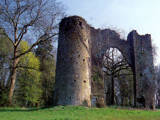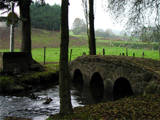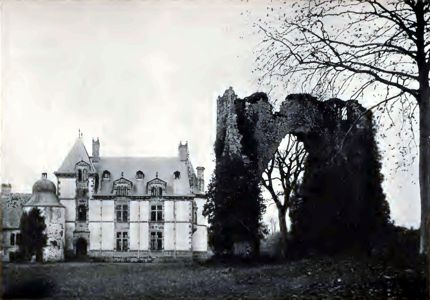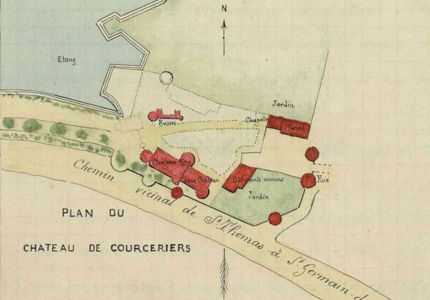 |  |
|
Voici l'histoire de Courceriers, de son origine, l'ancien château fort et le château plus tard construit sur 2 époques. C'est aussi, dans une certaine mesure l'histoire des environs et de la commune de St-Thomas-de-Courceriers. L'histoire est l'oeuvre de Ch. L Bosse, curé de l'église de Saint-Thomas à partir des années soixantes. L'histoire a été écrite en 1967. Nous pouvons trouver aucune trace de Ch. Bosse ou toute référence à l'original de ce travail. Le texte est reproduit à partir d'une photocopie contribué par Philippe Trahais et l'on croit être libre de droit d'auteur, mais si vous pouvez ajouter quelque chose à ce sujet ou Ch. Bosse et son travail, svp contacter le webmaster. Le travail est reproduit dans son français original et dans une traduction anglaise. La traduction n'est pas littérale comme ce causerait une langue très étrange, mais est une meilleure interprétation du sens destiné par Ch. Bosse. Si vous pouvez ajouter quoi que ce soit à l'histoire de la commune s’il vous plaît contacter le webmaster en vue de développer cette section du site Web. Profitez de l'histoire! Choisissez votre langue préférée dans le menu ci-dessus. |
|
This is the story of Courceriers: its origin, the ancient castle and the later château which was constructed in two periods. It is also to some extent the history of the surrounding area and the commune of St-Thomas-de-Courceriers. The story is the work of Ch. L Bosse, curate of the church of St Thomas from the early sixties. His story was written in 1967. We can find no record of Ch. Bosse or any reference to the original of this work. The text is reproduced from an old photocopy contributed by Philippe Trahais and is believed to be free of copyright but if you can add anything about this or Ch. Bosse and his work, please contact the webmaster. The work is reproduced in its original "old" French and in an English translation. The translation is not literal as this would lead to some very strange language but is a best interpretation of the meaning intended by Ch. Bosse. If you can add anything to the history of the commune please contact the webmaster with a view to expanding this section of the website. Enjoy the story! Choose your preferred language from the menu above. |
 |  |
|
Cliquez pour l'agrandir | Click to enlarge |
| Voir la page de Cartes Postales pour plus de photos du château ou cliquez sur l'image ci-dessus | See the page Cartes Postales for more pictures of the chateau or click the image above |
Par Monique Guéguen apres Excursion à Saint-Thomas-de-Courceriers 25 septembre 2011 (la Société d'Archéologie et d'Histoire de la Mayenne) Aujourd'hui, le domaine de Courceriers offre sur un vaste espace ruines, bâti encore debout, de petits détails architecturaux qui permettent de saisir, bien incomplètement cependant ce qu'il a vécu au fil des temps. Elevé sur un petit plateau, la Vaudelle court encore au pied de ses fortifications importantes. Le premier seigneur à avoir engagé la construction de la forteresse médiévale semble être Gervais de Courceriers. Son nom figure parmi les assistants à la fondation du prieuré de Fontaine-Géhard. Il fut généreux donateur des abbayes d'Etival et Evron. Croisé avec Geoffroy de Mayenne, il assista au siège de Jaffa. Guillaume de Courceriers dit le jeune fonda en 1418 la chapelle saint Jean et la dota d'une métairie en Pézé le Robert. Sa porte ogivale fut surmontée d'une rosace suite à un incendie qui dévasta la nef au milieu du 19 ème. Guillaume maria sa fille Guillemette à Ambroise de Loré né à Oisseau. Ce gendre, engagé très jeune dans la lutte contre les anglais mena dans le Maine attaques et embuscades. En 1419, réfugié au château de Courceriers, les anglais l'attaquèrent et s'emparèrent de la forteresse. Incapables de la défendre, ils préférèrent la détruire. Aujourd'hui, de cette époque, s'élèvent à une quinzaine de mètres, les ruines de la porte d'entrée avec à droite une tour carrée et à gauche une tour ronde. La motte avait été nivelée à la fin du 16 ème siècle. Sur la tour à la toiture en forme de cloche, on retrouve quelques traces d'ouvertures en plein cintre ainsi que dans le bâtiment qui lui est proche. Sur un des pignons de celui-ci, une avancée en surplomb d'éléments d'architecture soignée et décorée peut faire penser à des latrines (14 ème). François du Plessis-Châtillon fit construire un petit château terminé en 1590. Amoureux de l'Italie qu'il avait parcourue en 1577 et 1578, il en décore la salle principale d'une fresque représentant un César triomphant. On lui apporta des modifications au 19 ème. Il fut totalement détruit dans les années 1960. |
By Monique Guéguen after an excursion to Saint-Thomas-de-Courceriers September 25, 2011 (the Société d'Archéologie et d'Histoire de la Mayenne) Today, the Courceriers estate offers, on a vast ruined space, buildings still standing, small architectural details which allow us to grasp, albeit incompletely, what it has experienced over the years. Raised on a small plateau, the Vaudelle still runs at the foot of its important fortifications. The first lord to have started the construction of the medieval fortress seems to be Gervais de Courceriers. His name appears among those who helped found the priory of Fontaine-Géhard. He was a generous donor to the abbeys of Etival and Evron. A crusader with Geoffroy de Mayenne, he was present at the siege of Jaffa. Guillaume de Courceriers, known as the young creator, founded the chapel of Saint John in 1418 and endowed it with a smallholding in Pézé le Robert. Its ogival door was surmounted by a rose window following a fire which devastated the nave in the middle of the 19th century. Guillaume married his daughter Guillemette to Ambroise de Loré born in Oisseau. This son-in-law, engaged very young in the fight against the English, led attacks and ambushes in Maine. In 1419, taking refuge in the castle of Courceriers, the English attacked him and seized the fortress. Unable to defend it, they preferred to destroy it. Today, the ruins of the entrance gate, with a square tower on the right and a round tower on the left, are about 15 metres high. The mound was levelled at the end of the 16th century. On the tower with its bell-shaped roof, there are traces of arched openings, as well as in the building next to it. On one of the gables of the latter, an overhang of carefully decorated architectural elements may suggest a latrine (14th century). François du Plessis-Châtillon had a small château built in 1590 and, having visited Italy in 1577 and 1578, he decorated the main room with a fresco depicting a triumphant Caesar. Modifications were made in the 19th century. It was completely destroyed in the 1960s. |
